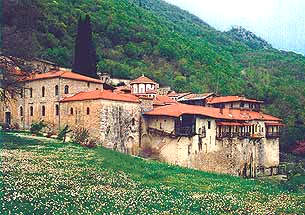 At an altitude of 750 m on the slopes of Koziakas, the monastery was re-founded between 1527-1535 by Saint Vissarionas, archbishop of Larissa, when the saint was ex-priest of Stagon.
At an altitude of 750 m on the slopes of Koziakas, the monastery was re-founded between 1527-1535 by Saint Vissarionas, archbishop of Larissa, when the saint was ex-priest of Stagon.
On the place of the church built by Saint Vissarion with the help of his brother Ignatius, the current cathedral of the monastery was built from the ground up in 1557 by the metropolitan of Larissa Neophytos II and the bishops Dimitriados Iosif, Litzas Loukas and Phanarios Martyrios (as evidenced by the building inscription).
The catholicon, which is honored in the name of the Transfiguration of the Savior, follows the Hagiorite style of the cruciform tetrakion, with two (today) domes and niches on its north and south sides. Its hagiography was done by the Constantinopolitan painter Gorgis. The wood-carved temple is later, since 1813. The once rich monastery with 365 cells and the rich library, which emerged as a spiritual center of the modern Hellenism, functions today with a few monks who guard its treasures. Among them there are the saint’s skull, the testament with the autograph signature, the staff and the vestments of Saint Vissarion.
The specific Monastery was the “ark” of the National Resistance. The first rebel units of Western Thessaly were housed there. In this Monastery there was also the famous handwritten gospel with the signature of Konstantinos Porphyrogenitus, which after several adventures and thefts, was found and is kept in the museum of the Holy Monastery of Varlaam of Meteora.
In 1823 the monastery was destroyed and the 2000 volumes of its library were burned by the Albanians of S. Kortzia. In 1943 the monastery was destroyed by the fire again.
The frescos of the Catholic Church of Dousikos Monastery (1557) are the work of a Cretan painter, Georges, who was probably a student of Theophanes on Holy Mountain. Georges, as at least, it can be seen from the study of the frescos of the Catholicon of the Dionysios Monastery, which have recently been preserved, faithfully follows the figurative types and artistic modes of Theophanes, but without the quality of the original, as his painting is more schematic and linear, whereas in an expressive level, the faces look worried, without the peaceful spirituality which is pervasive in Theofane’s paintings.

